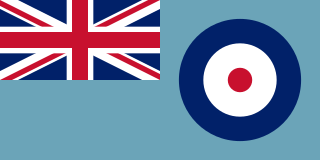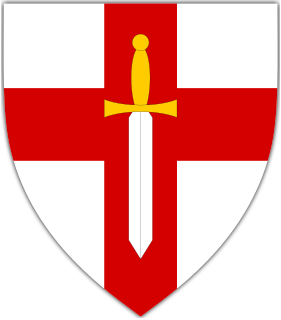
Harold Rupert Leofric George Alexander, 1st Earl Alexander of Tunis, was a senior British Army officer who served with distinction in both the First and the Second World War and, afterwards, as Governor General of Canada and the first Lord Lieutenant of Greater London in 1965.

The Desert Air Force (DAF), also known chronologically as Air Headquarters Western Desert, Air Headquarters Libya, the Western Desert Air Force, and the First Tactical Air Force (1TAF), was an Allied tactical air force created from No. 204 Group RAF under RAF Middle East Command in North Africa in 1941 to provide close air support to the British Eighth Army against Axis forces. Throughout the Second World War, the DAF was made up of squadrons from the Royal Air Force (RAF), the South African Air Force (SAAF), the Royal Australian Air Force (RAAF), the United States Army Air Forces (USAAF) and other Allied air forces.

The Allied invasion of Sicily, also known as Operation Husky, was a major campaign of World War II in which the Allied forces invaded the island of Sicily in July 1943 and took it from the Axis powers. It began with a large amphibious and airborne operation, followed by a six-week land campaign, and initiated the Italian campaign.

Operation Baytown was an Allied amphibious landing on the mainland of Italy that took place on 3 September 1943, part of the Allied invasion of Italy, itself part of the Italian Campaign, during the Second World War.

The First Army was a formation of the British Army that existed during the First and Second World Wars. The First Army included Indian and Portuguese forces during the First World War and American and French units during the Second World War.

The 6th United States Army Group was an Allied Army Group that fought in the European Theater of Operations during World War II. Made up of field armies from both the United States Army and the French Army, it fought in France, Germany, Austria, and, briefly, Italy. Also referred to as the Southern Group of Armies, it was established in July 1944 and commanded throughout its duration by General Jacob L. Devers.
This is the British First Army order of battle on 20 April 1943 during the Tunisia Campaign of World War II.
This is an outline order of battle of the British First Army on 4 May 1943 during the Tunisian Campaign of World War II.
Following the Kitchener Reforms of 1903 during the British Raj, the Commander-in-Chief, India, enjoyed control of the Army of India and answered to the civilian Viceroy of India. The Commander-in-Chief's staff was overseen by the Chief of the General Staff. General Headquarters India was based in Calcutta and Simla until the seat of power moved to New Delhi in 1911.
This is a timeline of the North African campaign.

The 78th Infantry Division, also known as the Battleaxe Division, was an infantry division of the British Army, raised during the Second World War that fought, with great distinction, in Tunisia, Sicily and Italy from late 1942–1945.

Portée describes the practice of carrying an artillery piece on a truck which can be fired from the vehicle or quickly dismounted and fired from the ground. The term is most often used to describe anti-tank equipments used by the British, Commonwealth and imperial forces in the Western Desert Campaign of the Second World War. Modern terms for mounting weapons on vehicles are technical or gun truck.

The Battle of Sidi Bou Zid(Unternehmen Frühlingswind/Operation Spring Breeze) took place during the Tunisia Campaign from 14–17 February 1943, in World War II. The battle was fought around Sidi Bou Zid, where a large number of US Army units were mauled by German and Italian forces. It resulted in the Axis forces recapturing the strategically important town of Sbeitla in central Tunisia.

The Persia and Iraq Command was a command of the British Army established during the Second World War in September 1942 in Baghdad. Its primary role was to secure from land and air attack the oilfields and oil installations in Persia and Iraq. Its further role was to ensure the transport of supplies from Persian Gulf ports through Iraq and Persia to the Soviet Union.
Operation Diadem order of battle is a listing of the significant formations that were involved in the fighting on the Winter Line and at the Anzio bridgehead south of Rome during Operation Diadem in May - June 1944 which resulted in the Allied breakthrough at Cassino and the breakout at Anzio leading to the capture of Rome.
The Mediterranean Air Command (MAC) was a World War II Allied air-force command that was active in the North African and Mediterranean Theater of Operations (MTO) between February 18 and December 10, 1943. MAC was under the command of Air Chief Marshal Sir Arthur Tedder, whose headquarters were next to those of the Supreme Allied Commander, General Dwight D. Eisenhower, in Algiers, Algeria, during the planning of the Allied campaigns in Tunisia, Pantelleria, Sicily, and the invasion of mainland Italy during the war.

General Sir William Duthie Morgan, was a British Army officer. During the Second World War, he commanded the Mediterranean Theatre of Operations during the late stage of the war.
Operation Grapeshot order of battle is a listing of the significant formations that were involved in the Spring 1945 offensive in the Apennine Mountains and the Po valley in northern Italy, April 1945 – May 1945.

Lieutenant General Sir Humfrey Myddelton Gale, was an officer in the British Army who served in the First and Second World War, during which he was Chief Administrative Officer at Allied Forces Headquarters and later SHAEF under General Dwight D. Eisenhower. After the Second World War he was European Director of the United Nations Relief and Rehabilitation Administration, worked for the Anglo-Iranian Oil Company, and was chairman of the Basildon, Essex New Town Development Corporation












